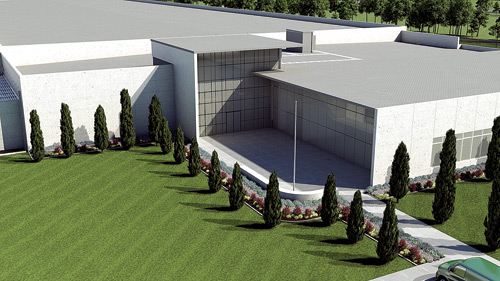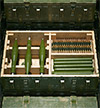Siting Next-Generation Data Centers
Although the attributes for data center development continue to evolve, environmental and zoning issues; transportation, telecom, and power needs; and available labor are still important considerations.
Q2 2021

While good news to many consumers, this is even better news to communities seeking to attract the data centers where the millions of terabytes of information collected by these technologies are stored. Demand for secure data storage continues to increase, with the U.S. data center construction market expected to grow 9 percent each year through 2025.
The next generation of data centers, however, will likely differ from the current stock in several key ways. The criteria driving site selection may, in some cases, also be changing. As a result, corporate real estate executives as well as economic development groups seeking to land these projects might need to recalibrate their efforts.
How Data Centers Are Evolving
The current crop of hyperscale data centers tends to comprise exceptionally large, buffered facilities that can be expanded rapidly, efficiently, and indefinitely. Many house vast amounts of mission-critical government and business data that require the highest levels of security and have no appetite for interruption to their 24/7 operation.
The next generation of data centers will include many that house slightly less sensitive consumer-driven and product-based data. While no one wants data on their refrigerator’s contents or temperature preferences compromised, the operational risks and security expectations associated with this data are on a different order of magnitude than, say, military and personal financial data.
Many of these data centers will also be smaller and more compact. Most will be located in proximity to the companies or industries that use them. Instead of single-story structures located on sprawling sites, tomorrow’s data centers will at times be two and three stories high and located on infill space without a significant buffer. Along with concerns for 24/7 uptime and data security, developers may place higher priority on energy efficiency and other ways to minimize operational costs.
While the ideal attributes for data center development continue to evolve, most developers have similar areas of interest:
The next generation of data centers will include many that house slightly less sensitive consumer-driven and product-based data. Geography —
Because data centers have 24/7/365 operations, any interruption in service could have unfortunate consequences. That is why site selectors still tend to prefer locations void of wetlands, flood plains, fault lines, and other environmental encumbrances that make them prone to natural disasters.
Sites located near active rail lines, busy surface transportation routes, and airport flight paths can also be problematic due to the vibration risks associated with them. Tracts that cannot be accessed via municipal or domestic utilities are also not ideal.
Geotechnical and environmental considerations —
Site selection teams look for detailed information on the geotechnical makeup of a proposed site, including soil types; the depth of the water table and any known aquifers; locations of boreholes, wells, and trial pits; and a host of other geophysical conditions. These teams also are expected to provide the results of an environmental analysis, including information on fuel storage tank requirements, air permitting limitations, wetlands delineation, and endangered species analysis.
It also pays to be upfront about any natural environmental encumbrances that may require mitigation before development. Teams should be prepared to provide Phase I and, if warranted, Phase II environmental assessments, along with the identification of current and past site activities and environmental contamination.
Planning and zoning —
Site selectors want to know that a proposed property is or can be zoned for data center construction. They seek information on future land use allowances and variance feasibility, as well as boundary setback requirements, building height restrictions, environmental sustainability requirements, and other zoning considerations. Information on permit time frames and any fast-track permitting processes may also prove helpful.
Site selection teams look for detailed information on the geotechnical makeup of a proposed site. Zoning information on the surrounding area could be requested as well. For example, site selectors are interested in knowing a site’s proximity to dissimilarly zoned areas. Land parcels should be appropriately scaled to provide significant protection from adjacent properties.
Transportation —
Site selectors are interested in any limitations or restrictions on the access routes between data centers and suppliers. They’ll also want to know about local traffic patterns, traffic safety concerns, and any roads or other civil improvements needed to accommodate increased traffic volume. Site ingress and egress, parking, and industrial vehicle turning radii are among the other transportation details they seek.
Given that data center management and allied staff will likely be located outside of the region, proximity to commercial air service is important to the site selection team. A three-hour drive to the nearest airport can put a community at a severe disadvantage.
Electric power —
Data centers require large quantities of redundant, reliable, and low-cost electric power. While power needs ebb and flow, the next generation of smaller data centers will typically require 50 megawatts (MW) of available power that is expandable, accessible through redundant feeds, and ideally served by its own dedicated substation.
When assessing the ability to deliver 24/7 power, site selectors will want to understand the relationships between power generators, grid operators, and distribution/transmission operators, along with routing, capacities, substations, voltages, and redundancies, among other things. Identifying the power generation mix for proposed sites and what, if any, renewable resource opportunities are available is a necessity when looking at power sources.
Electric rates are usually a significant driver in site selection. To be competitive, a region will likely need to offer electric rates below 5 cents per kilowatt hour (kWh). Importantly, the ability to identify which power rate category a data center may fall under — including rate structure and type, tariffs, and other rate components and market impacts — is a must. Lead times for utility supply must be confirmed. Site selectors also want to understand the site’s priority if load shedding must occur.
Water and wastewater services —
Data centers require a good water source and large amounts of water for cooling. While loads vary, it is safe to assume that a data center will require more than one million gallons of water a day. Site selectors will also be interested in learning the peak and total volume availability, along with infrastructure redundancy and water quality data.
On the wastewater side, site selectors need to know the location, proximity, and capacity of the nearest wastewater treatment facility, as well as its peak capacity, daily volume limits, and process wastewater requirements. They will also seek permitting and other requirements for water use and wastewater treatment and discharge, along with pipeline and infrastructure routing details.
Location selection is frequently impacted by the latency and redundancy of telecommunications infrastructure. Telecommunications —
Data center operations depend on the services of both long-haul fiber and short-haul telecom providers. Location selection, in fact, is frequently impacted by the latency and redundancy of telecommunications infrastructure. Site selectors are also interested in a site’s dark fiber and networking infrastructure. Maps indicating the fiber network routes and the locations of nearby fiber maintenance holes help complete the picture.
Natural gas —
Be prepared to provide information on the gas supplier(s) to a proposed site, the locations of any existing natural gas lines, proposed routing for planned expansions, and the natural gas supply lead time.
Potential sites that are in proximity to large-scale natural gas transmission lines are usually avoided due to potential fire risks. Site selectors are also interested in natural disaster risk information, emergency evacuation plans and policies, radon gas levels, and historical information on natural disasters in the region.
Labor pool —
While a large, hyperscale data center may employ 200 or more highly skilled engineers and technicians, tomorrow’s more compact centers will require only a fraction of that number. Still, potential locations must have a readily available labor pool that includes engineering, technical, and allied talent living within commuting distance. Site selectors will also be interested in learning about salary expectations and the status of organized labor in the region.
Putting It All Together
The more detailed information that can be pulled together about proposed data center sites, the better. In a perfect world, site selectors would receive maps of potential sites, including all built- and natural-environment attributes and routes drawn to scale — to the extent allowed under Homeland Security protections — with noted water and electric power sources.
A map indicating all of a site’s attributes helps decision-makers judge how a site can be developed to accommodate a prospective data center, saving time and mitigating the development team’s risk assumptions.
If a site is located within a larger development tract, a master plan for the development — indicating proposed site boundaries, easements and encumbrances, and precise acreage data — is also important. A site selector will also want to know who has jurisdictional control of the site and about any impediments there might be to its development. A topographic survey, including contour drawings, wetlands, flood plains and other potential natural-environment impediments, will help speed the decision-making process.
The icing on the cake is a proposal that offers lower, bundled electric rates and incentives; affordable land costs; and an available, professional workforce. Taken together, it may seem like a lot to ask. But it will strengthen a competitive position when it comes to attracting the coming wave of data centers.
Project Announcements
Amazon Plans Warren County, Mississippi, Data Center Operations
11/24/2025
Meta Plans Beaver Dam, Wisconsin, Data Center Operations
11/15/2025
DartPoints Expands Greenville County, South Carolina, Data Center Operations
11/15/2025
Lambda Plans Kansas City Missouri, AI Operations
11/11/2025
Google Plans West Memphis, Arkansas, Data Center Operations
10/14/2025
Ireland-Based Kerry Plans Lehigh Valley, Pennsylvania, Production Operations
10/07/2025
Most Read
-
The Workforce Bottleneck in America’s Manufacturing Revival
Q4 2025
-
Rethinking Local Governments Through Consolidation and Choice
Q3 2025
-
Data Centers in 2025: When Power Became the Gatekeeper
Q4 2025
-
Tariff Shockwaves Hit the Industrial Sector
Q4 2025
-
Investors Seek Shelter in Food-Focused Real Estate
Q3 2025
-
The Permit Puzzle and the Path to Groundbreaking
Q3 2025
-
Supply Chain Whiplash Reshapes CRE
Q3 2025



